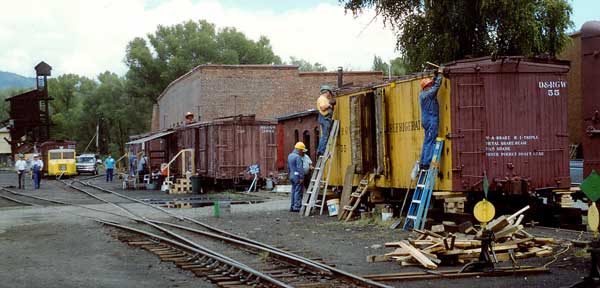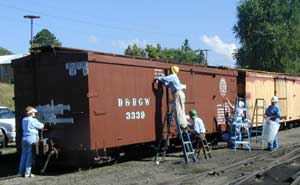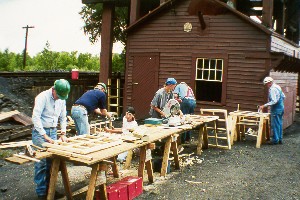 |

 |
| Volunteers at work in the Chama yard, 2002. Photo: Tom Cardin. |
The Friends of the C&TS is a volunteer organization dedicated to preserving, restoring and intrepreting the historical character of the railroad. In 1970 when the states of Colorado and New Mexico jointly purchased 64 miles of the Denver & Rio Grande Western narrow gauge railroad between Antonito, Colorado and Chama, New Mexico, they acquired a large collection of historic buildings and rolling stock. While the railroad is owned by the states of New Mexico and Colorado, the day to day operations are handled by a contracted operator who is responsible for the upkeep of the equipment needed for daily operations, and for the track. Unfortunately this organizational structure did not provide for the maintenance of the unused historic equipment and buildings, nor for the interpretation of the history of the railroad to the visiting public. The Friends of the C&TS was created to fill this need.
 |
| Painting and lettering: A time-honored Friends tradition. Photo: Tom Cardin. |
By 1980, ten years after the birth of the C&TS, much of the unused historic property was falling into decay. Recognizing the need to do something, Albuquerque attorney Bill Lock approached the railroad about establishing a volunteer preservation program. Their first project was an old refrigerator car body in Chama that had once served as a bunk house. In 1981 Lock and a friend spent a day and a half performing minor carpentry repairs and repainting the car. The following year Lock and a few more friends returned to renovate caboose No. 0503, the only caboose the C&TS was allowed to purchase from the Rio Grande. Focusing on the historic D&RGW rolling stock in the Chama yard, these weekend work parties grew year by year, to the point that some 70 volunteers participated in 1987. In 1988 the Friends of the Cumbres & Toltec Scenic Railroad was incorporated, setting the stage for an impressive string of achievements.
In 1989 the Friends embarked on a multi-year effort to save what was left of the D&RGW facilities at 10,015-foot Cumbres Pass, one of the legendary locations in American railroading. The remaining portion of the 400-foot snowshed covering the wye was stablized, the derilect car inspector's house--which was on the verge of collapse--was stabilized and cosmetically restored, and the section house was reroofed and painted.
 |
| Volunteers re-chink the nineteenth century hand-hewn log bunkhouse at Sublette. |
The success at Cumbres led to a similar effort to stabilize and restore the facilities at Sublette, New Mexico, a typical Rio Grande section town. The small cluster of structures includes a section house and a hand-hewn log bunkhouse--both of which were built shortly after the tracks reached this point in 1880--as well as a coal house and a shingle-sided bunkhouse. Between 1991 and 1995 volunteers completed a thorough exterior restoration of the town, including re-roofing most of the buildings, re-chinking of the log bunkhouse, and applying paint to return the town to its appearance in the last years of Rio Grande operations. In 1993 the Friends began work at Osier, Colorado, where the station and section house (which date to 1880 and 1884 respectively) were returned to their original appearance, having been previously converted into a make shift dining hall and restroom facility in the early days of the C&TS. In Antonito, Colorado, the Friends created a dual gauge static display to illustrate the difference between narrow gauge and standard gauge rails and equipment.
The Friends also returned several pieces of rolling stock to home rails, including a rare D&RGW short refrigerator car, six double-deck sheep cars, and two D&RGW passenger coaches. Most exciting, however, was the return of six former UTLX narrow gauge tank cars. Built by the D&RGW between 1924 and 1930, these cars were among 50 or so that hauled oil into the early 1960s between Chama and a refinery in Alamosa, Colorado. None of these cars were available from the D&RGW when the the C&TS was created in 1970--a notable omission since the Chama yard still has an oil loading dock.
As the Friends matured as an organization, intrepreting the railroad and presenting the history of the area to the public became a major goal. In that light, the Friends designed and provide free of charge a walking tour of the facilities at both Chama and Antonito. Tens of thousands of walking tours, in both English and Spanish, have been printed and distributed to the public. The Friends have also established a docent program to provide interpretation and information to passengers riding the trains.
 |
| Making windows for the coal tipple. |
Today, the Friends is an organization of nearly 2400 members from all 50 states, and from several countries overseas. The Friends conducts six week-long work sessions each year--two each in May, June and August--involving hundreds of volunteers, many of whom participate in more than one session. The scope of the work includes the traditional Friends activities of car restoration and painting, the stabilization and restoration of virtually all of the historic structures along the line, general clean-up and aesthetic improvement of the property, and interpretation of the railroad.
The Friends welcomes as a member anyone who shares this mission. Whether you join only to receive our quarterly newsletter, the C&TS Dispatch, or to volunteer at a summer work session, you will be helping to preserve this remarkable railroad. To learn how to become a member, visit our Join Or Give page.
|
 |






